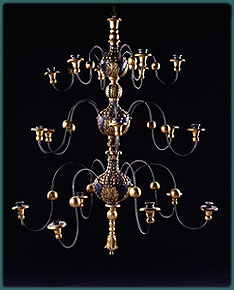The historian Fernand Braudel tells us that "the rule up to the seventeenth century was to paint furniture, ceilings, walls . . . proof of a mad taste for light, bright colours in dark interiors with few openings to the outside." The patina of age and the story of past time have an appeal that transcends simple, utilitarian use. These are objects whose strength of colour and vigorous line are as powerful in their own right as are the images proposed by the old masters. Witness to another time and sensibility, they can also be read as signs of demographic and social phenomena related to our physical being in the material world. |
 Chandelier Late 18th century Canadian Museum of Civilization
|
![]()
Date Created: March 1997 | Last Updated: September 1, 2009



